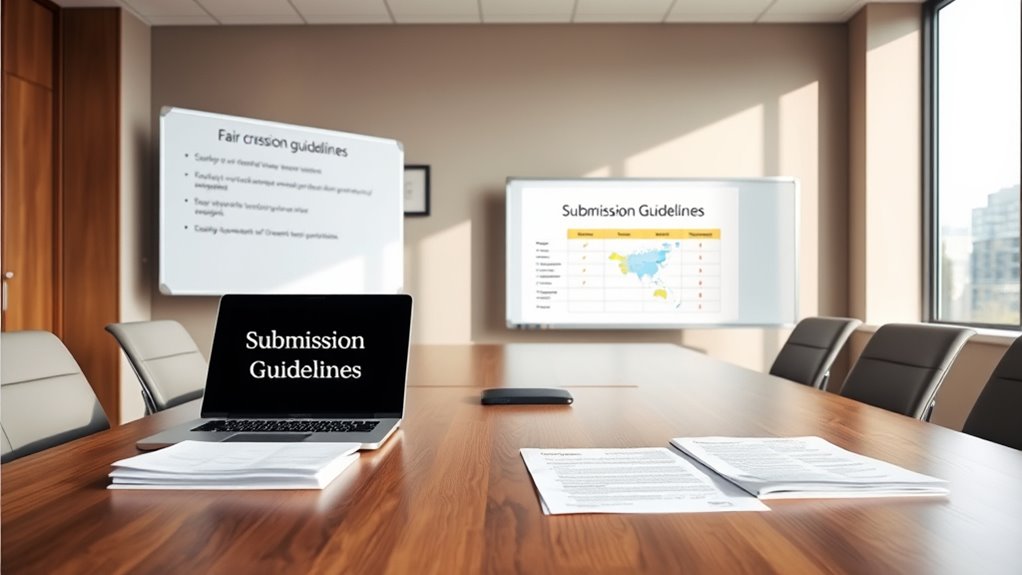To credit audience evidence submissions fairly, you should set clear guidelines for what evidence counts and how to submit it, ensuring everyone understands the process. Apply objective evaluation criteria consistently, such as relevance and originality, and use rubrics to keep assessments fair. Recognize all contributors openly and transparently, providing constructive feedback. Regularly review and update your process to foster trust and inclusivity—keep going to learn more about perfecting your approach.
Key Takeaways
- Clearly define and communicate the criteria for acceptable evidence and proper labeling standards to all contributors.
- Establish transparent submission procedures with deadlines, formats, and instructions for acknowledgment.
- Develop objective evaluation rubrics that assess relevance, accuracy, and originality consistently across all evidence.
- Recognize contributions publicly and equitably, highlighting specific roles and efforts of each participant.
- Regularly review and update crediting practices based on feedback to ensure fairness and maintain trust among stakeholders.
Establish Clear Submission Guidelines

To guarantee that audience evidence submissions are credited fairly, you need to establish clear guidelines from the start. First, specify what types of evidence are acceptable, such as documents, videos, or testimonials. Clearly outline the submission process, including deadlines, formats, and required information. Make sure everyone understands how to label their submissions correctly, so there’s no confusion. Provide detailed instructions on how to submit evidence, whether through email, online portals, or physical drop-offs. Transparency at this stage helps prevent misunderstandings and ensures submissions are consistent. Additionally, referencing best practices in content organization can facilitate a more efficient review process. By setting these standards early, you create a fair process where everyone knows what’s expected, making it easier to review and credit evidence accurately.
Implement a Transparent Evaluation Criteria

You need to set clear standards for evaluating submissions so everyone understands what’s expected. Communicating these criteria openly guarantees fairness and builds trust with your audience. When your evaluation process is transparent, all participants feel confident that their evidence is judged fairly. Incorporating consistent criteria helps maintain the integrity of your content platform.
Subheading 1: Define Clear Standards
Establishing clear standards is essential for ensuring that audience evidence submissions are evaluated fairly. When you set specific criteria, you create a consistent framework everyone understands. To do this effectively, consider these steps: 1. Define objective measures, like relevance and accuracy, so submissions can be judged uniformly. 2. Set thresholds for quality, such as completeness or clarity, to distinguish strong evidence from weaker input. 3. Establish deadlines and submission formats, ensuring all participants adhere to the same process. Additionally, understanding the importance of emotional support in evaluating submissions can help foster a respectful and constructive review environment.
Subheading 2: Communicate Criteria Openly
Once the standards for evaluating audience evidence are set, it’s essential to communicate these criteria openly with all participants. Clearly share the evaluation process, including what aspects you’ll prioritize and how scores will be assigned. This transparency helps build trust and minimizes misunderstandings. Use straightforward language and provide examples if possible, so everyone understands how their submissions will be judged. Make sure the criteria are accessible—consider posting them publicly or sharing them in advance. Encouraging questions and feedback ensures clarity and demonstrates your commitment to fairness. When everyone knows the rules upfront, it becomes easier to assess submissions objectively, and participants feel confident that their efforts are evaluated consistently and honestly. Additionally, understanding risk assessment for merchant services can help inform how you communicate evaluation criteria to address potential concerns regarding security and compliance.
Recognize All Contributors Equitably

To guarantee fairness, you need to acknowledge every participant involved in the evidence submissions. Clearly define each person’s role so contributions are understood and properly credited. By doing so, you create an environment where all contributors feel recognized and valued. Recognizing diverse contributions ensures that all forms of input are appreciated and properly integrated into the overall assessment.
Acknowledge All Participants
Recognizing all participants guarantees that everyone who contributed to the evidence submission feels valued and fairly acknowledged. To do this effectively, follow these steps:
- Identify all contributors early in the process to ensure no one is overlooked.
- Highlight specific roles and efforts of each participant, so their unique input is clear.
- Use inclusive language when giving credit, emphasizing collective effort and individual contributions.
- Recognizing diverse contributions helps create an inclusive environment where all efforts are appreciated.
Clarify Contribution Roles
Clarifying contribution roles is essential to guarantee all contributors are recognized fairly. When you define each person’s specific responsibilities early on, everyone understands their part in the process. This clarity helps prevent misunderstandings and ensures credit is allocated appropriately. Make sure to communicate roles clearly, whether it’s drafting, reviewing, or providing evidence. Document these roles in writing, so there’s no ambiguity later. By doing this, you create transparency and foster a sense of fairness among all participants. When contributions are clearly outlined, it becomes easier to assess individual input and give proper recognition. This approach also helps resolve disputes quickly, as everyone knows their responsibilities and how their work fits into the larger picture. Additionally, understanding meditation and other practices that enhance focus and mindfulness can improve collaboration and overall process quality. Ultimately, clarifying roles promotes fairness and accountability throughout the evidence submission process.
Use Objective and Consistent Assessment Methods

Using objective and consistent assessment methods is essential to guarantee fairness when crediting audience evidence submissions. You should establish clear criteria beforehand, ensuring everyone understands how submissions are evaluated. To do this effectively: 1. Develop specific rubrics that measure relevant qualities like originality, relevance, and clarity. 2. Apply these rubrics uniformly across all submissions, avoiding subjective judgments. 3. Regularly review and update your assessment tools to maintain fairness and accuracy. Incorporating standardized evaluation criteria, such as those used in home theatre projectors like contrast ratios and color accuracy, can further improve assessment fairness.
Communicate Feedback and Recognition Effectively

Effective communication of feedback and recognition is essential for motivating your audience and reinforcing fair assessment practices. Be clear and specific when sharing feedback, highlighting exactly what was done well and areas for improvement. Use a respectful tone to guarantee recipients feel valued and understood. Recognize contributions publicly when appropriate, which encourages continued engagement and reinforces fairness. Avoid vague comments; instead, provide concrete examples to support your points. Timeliness matters—deliver feedback promptly so it remains relevant. Acknowledge efforts and achievements fairly, ensuring everyone understands their contributions are appreciated. When you communicate effectively, you build trust and encourage honest participation. Clear, considerate feedback fosters a positive environment where fair recognition is understood and appreciated, motivating your audience to maintain high standards. Incorporating water-based activities, such as aquatic exercises, can also promote a more dynamic and engaging feedback process by encouraging open communication in a relaxed setting.
Regularly Review and Update Your Crediting Process

Once you’ve established clear ways to communicate feedback and recognize contributions, it’s important to keep your crediting process aligned with evolving practices and standards. Regular reviews help guarantee fairness and transparency. To do this effectively:
- Schedule periodic assessments of your crediting criteria to reflect new norms or community expectations.
- Gather feedback from contributors and stakeholders about their experiences and suggestions for improvement.
- Update your procedures based on these insights, making sure processes remain clear, consistent, and equitable.
- Ensure your process incorporates transparency in sourcing and manufacturing processes, which is vital for maintaining trust and authenticity in recognition.
Frequently Asked Questions
How Do I Handle Anonymous Audience Submissions Fairly?
You handle anonymous audience submissions fairly by establishing clear guidelines upfront, ensuring everyone understands how their contributions will be used and credited. When reviewing submissions, focus on the content rather than the source, and avoid assumptions. If you decide to credit ideas, do so collectively or anonymously, and inform your audience about your process. This transparency builds trust and maintains fairness, encouraging ongoing participation from all members.
What Should I Do if There’s a Dispute Over Credit?
If there’s a dispute over credit, you should review the original submission details and communicate openly with both parties involved. Ask for any supporting evidence or documentation they can provide. If needed, consult your policies or guidelines to guarantee fair handling. Ultimately, you want to find a resolution that recognizes everyone’s contributions accurately, maintaining transparency and fairness throughout the process. Clear, respectful dialogue helps resolve disputes effectively.
How Can I Ensure Diverse Voices Are Equally Recognized?
Think of your audience as a garden; every voice is a unique flower that needs tending. To guarantee diverse voices are equally recognized, actively seek out contributions from underrepresented groups and create inclusive platforms. Fairly credit each submission, acknowledging different perspectives without bias. Regularly review and adjust your process to prevent any voice from wilting unnoticed. By nurturing this diversity, you cultivate a rich, vibrant environment where everyone’s contribution blossoms.
What’s the Best Way to Prevent Bias in Assessment?
To prevent bias in assessment, you should establish clear, objective criteria that everyone understands. Be aware of your own potential biases and actively question assumptions. Use blind review processes when possible, and involve diverse evaluators to get multiple perspectives. Regularly review assessment outcomes to identify patterns of bias, and adjust your methods accordingly. By staying transparent and consistent, you guarantee fairness and minimize personal prejudices influencing judgments.
How Often Should I Reassess My Crediting Policies?
You should reassess your crediting policies at least annually to guarantee fairness and relevance. Regular reviews help you catch biases, adapt to changes, and improve credibility. If you notice inconsistencies or receive feedback indicating issues, reassess more frequently. Make it a routine part of your evaluation process, and document updates to maintain transparency. Staying proactive guarantees your policies stay aligned with best practices and audience expectations.
Conclusion
By following these steps, you guarantee your audience evidence submissions are credited fairly and transparently. Some might think this process takes too much time, but investing in clear guidelines and consistent evaluation saves effort in the long run. When everyone feels recognized and valued, your community becomes stronger and more engaged. Ultimately, fair crediting isn’t just about rules; it’s about building trust and encouraging ongoing participation.









